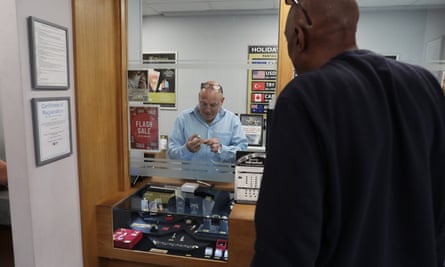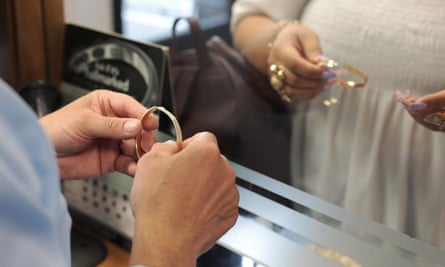A sturdy chain and slender cross, both made of gold, are placed on the desk in a small plastic bag. Its owner is pondering whether to pawn or sell her grandmother’s necklace and mother’s pendant to raise £400 in cash to pay off debts and fund her daughter’s birthday celebrations. She has never used a pawnbroker before, but her finances are under increasing pressure.
“Every month I have got nothing to live on,” says the client, who declined to be identified, as she fights back tears. “I’ve been sitting around the house planning things I can sell. I’m out of the house for nine or 10 hours a day five days a week and I’m still skint five days after I get paid.”
The customer is one of many to cross the threshold on a typical day at Pickwick in Ashford, Kent, part of a chain of eight pawnbrokers – an industry that is experiencing a boom as customers struggle for cash to pay rising bills.
The company’s profits dived during the pandemic when it lost at least a third of its loan book, as clients with little opportunity to spend paid off their debts. Now business is bouncing back – up 20% since January to almost 60% above pre-Covid levels. “I have not really seen this pace of growth before. I think we are in new territory,” says Nathan Finch, Pickwick’s managing director.
 View image in fullscreenNathan Finch with a customer at Pickwick in Ashford. ‘If we have to sell the items, it’s a failed loan.’ Photograph: Martin Godwin/The Guardian
View image in fullscreenNathan Finch with a customer at Pickwick in Ashford. ‘If we have to sell the items, it’s a failed loan.’ Photograph: Martin Godwin/The Guardian
“I think people are arming up in respect of their finances. Pawnbroking customers are particularly savvy and are often smoothing their cashflow and making sure they have [what they need for] a bill coming up.”
Finch expects a further uplift this year as the high inflation and imminent recession predicted by the Bank of England this week, plus energy bills forecast to hit £3,600 a year, add to the soaring cost of living.
Demand at UK’s biggest pawnbroker at record high amid cost of living crisisRead more
Access to other forms of short-term credit, such as payday lending, has reduced with the demise of some key players, leaving pawnbroking to fill the gap. The industry has also benefited from the soaring value of gold and diamonds, rise in demand for designer watches and increased awareness via TV shows such as Channel 4’s Posh Pawn.
It is a revival for a sector that was as ubiquitous as pubs in the Victorian era but that had shrunk over the 20th century with the rise of other forms of credit. Two of its largest players – The Money Shop and Albemarle & Bond – collapsed shortly before the pandemic.
Finch says: “Historically it was a working-class thing, but I don’t think you can put customers into a class now. Everyone occasionally has more bills than they earned in that particular month.”
While he says customers have pawned expensive watches to fund investments in racing cars, the typical client borrows for a holiday or an unexpected cost such as the breakdown of a car or central heating system, or a larger than anticipated business or home expenses.
Although heavily regulated, pawnbroking allows customers to borrow quite large sums without credit checks or proof of income. Borrowers must provide photo ID and proof of address, but the transaction hinges on the item of security provided. Lenders focus not on the borrower’s finances, just on the market value of the collateral, ensuring it can cover the cost of the loan and interest charges in case of default. Typically a broker will lend up to 70% of the item’s market value.
 View image in fullscreenFinch examines a customer’s jewellery. Photograph: Martin Godwin/The Guardian
View image in fullscreenFinch examines a customer’s jewellery. Photograph: Martin Godwin/The Guardian
Pawnbroking is about personal relationships, Finch says, with experienced staff able to spot someone trying to borrow against an item they may not actually own, and willing to haggle over the size of the loan. Regulars get better deals.
He says he has lent against vehicles and even gold false teeth, but the vast majority of loans are against jewellery. The pawnbroker plucks a box from one of the shop’s huge safes, full of pledges – the industry term for the item of security – each in a clear plastic ziplock bag alongside a pink contract laying out the terms of the loan.
There is a £90 loan against nine-carat-gold earrings, £300 on an 18-carat-gold necklace and a slew of chunky jewellery – large rings fashioned with a buckle, a saddle or the woven and studded design known as a keeper ring, which are favoured by many clients as a way to store wealth with the option to borrow against the asset.
Between 85% and 88% of pledges are redeemed, as clients are keen to retrieve often sentimentally important items. One of the fastest growing areas is men’s watches – especially Rolexes – and women’s designer bags and shoes, such as Gucci or Chanel. Finch says the redemption rate is high. “These are things people have worked hard for. It means something in the sense you have worked hard to buy and own it.”
Just before midday a regular comes in, Gary Thompson. The 55-year-old says he is borrowing about twice a month at present, a bit more than usual, as bills for his dog breeding business and home expenses have risen. He thinks he may have to pay for his dog to have an operation for the latest puppy litter and dog food prices are up. “Times are hard. I am borrowing to live,” he says.
Sporting a chunky gold chain and several large rings, he adds: “I only buy certain types of jewellery. They have their purpose I can take them home or put them down. I buy big things that I know I can come to the pawn shop and can ask for a big amount.”
An hour or so later, Wayne Cheeseman, 36, walks in wearing a massive bejewelled ring with a saddle design slung around his neck on a hefty gold chain and sporting several large sovereign rings on his fingers.
 View image in fullscreenMarisa Smedley and Wayne Cheeseman regularly borrow from Pickwick in Ashford. Photograph: Martin Godwin/The Guardian
View image in fullscreenMarisa Smedley and Wayne Cheeseman regularly borrow from Pickwick in Ashford. Photograph: Martin Godwin/The Guardian
Cheeseman says he bought lots of gold jewellery, as well as a house, after winning £1m on scratchcards in 2018. He uses some of his haul – including partner Marisa’s necklaces and rings – to borrow against once or twice a month to help cover costs. “It’s there if I need it,” he says. “It’s an investment. I don’t trust banks and my credit score is not all that.”
Cheeseman, who works as a carer, says: “I do a lot of hours but by the time I pay council tax, house insurance, the gas and electric and I don’t see nothing. Like everyone else we are struggling … Petrol is ridiculous and just to feed the dog costs £52 for a large bag of food when last year it was £45.”
Sign up to First Edition, our free daily newsletter – every weekday morning at 7am BST
He is now selling his house to move somewhere cheaper to cut costs and pay off debts, including about £2,000 borrowed against gold jewellery in Pickwick. Cheeseman says he likes the system as he always knows what he owes and can pay it off at any point within the seven-month contract without any penalties.
By law, pawnbrokers are not allowed to dispose of a pledge in less than six months and Pickwick gives at least seven months to redeem a loan and another month of warnings before the item is sold. As the contract comes to an end the interest can be paid off and loan renewed, giving further time to redeem.
Interest is charged, monthly, at between just under 2% for a large loan, of say £10,000 or more, to 10% for a small item (equivalent APRs 25% to 150%). Pawnbrokers are not allowed to sell for less than market value and if an item does sell for above the estimate, the customer gets the difference between the sale price and what is owed.
Finch says: “We do not want our customer to default, we want them to have a satisfactory outcome and to come back to us. If we have to sell the items, it’s a failed loan.”
The customer with the gold chain and cross comes back to the pawnbroker after taking some time to consider her options. She decides to sell as she does not want more debt of any kind. “I’ve been thinking about this for months,” she says. “This is what I want to do.”
This article was amended on 8 August 2022 to clarify that the interest rates cited as an example of the pawnbroking process are monthly, not annual, rates. The equivalent APRs have been added to the text for clarity.





Leave a Reply
You must be logged in to post a comment.